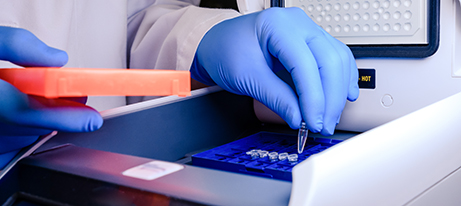
Getty Images / dhdezvalle
The cycle threshold (Ct) in reverse transcription polymerase chain reaction (RT-PCR) SARS-CoV-2 tests is gaining currency as a potential marker for severe disease in patients with COVID-19 illness. Amid mounting evidence in the clinical literature, however, some in the laboratory community are urging caution about the utility of this metric, how and even if it should be reported.
Ct refers to the number of cycles needed to amplify viral RNA to reach a detectable level. Certain testing platforms reveal Ct, but labs generally don’t provide the Ct value when reporting test results. It’s unclear how Ct should be applied in clinical settings. No standardization for Ct values exists across RT-PCR platforms, making it difficult to compare results among different tests. Researchers in clinical studies also haven’t validated using Ct to guide management of COVID-19 cases.
Several studies, however, point to a telling link between this viral load marker and severity of disease.
One review published in July in Infectious Diseases and Therapy reported an association between lower Ct values and not only worsening disease but also progression to severe disease and complications. Examining data from 18 studies, the investigators found significant correlations between Ct values and severe disease or death, as well as Ct and the presence of biochemical and hematological markers.
Two other studies published in October point to a relationship between viral load and disease outcomes and certain comorbidities.
One retrospective cohort study evaluated 314 patients admitted to the hospital with a positive SARS-CoV-2 test and viral pneumonia. Investigators used RT-PCR testing to group patients into three genomic load cohorts: low (Ct ≥35), intermediate (25<Ct<35), and high (Ct≤ 25). Following the patients for an average of 25 days, they determined that high genomic load at presentation predicted adverse outcomes independent of age, comorbidities, and severity of illness at presentation.
Previously, this team of researchers used Ct values from RT-PCR SARS-CoV-2 tests to assess viral load in 678 hospitalized COVID-19 patients in New York City (Clin Infect Dis 2020 doi: 10.1093/cid/ciaa851). Researchers found an association between higher viral load and factors such as increased age, smoking status, and recent chemotherapy. Higher viral load also independently correlated with higher risk of intubation and in-hospital mortality, observed Reed Magleby, MD, and colleagues.
The second study published in Nature Communications in October reported SARS-CoV-2 viral RNA in a substantial fraction of hospitalized patients (27%) and outpatients (13%) with COVID-19. “Viral load from the respiratory tract and plasma are associated with markers of disease severity and inflammation; and viral load, especially in plasma, can predict the risk of death,” study author Jonathan Li, MD, MMSc, assistant professor, Brigham and Women's Hospital and assistant professor of medicine, Harvard Medical School, told CLN Stat.
Findings of SARS-CoV-2 in plasma suggest that the virus isn’t just confined to the lungs “and may help explain the breadth of extrapulmonary manifestations of COVID-19, including pulmonary embolisms, strokes, cardiomyopathy, even COVID toes,” Li continued. “Importantly, our assay is able to report a true viral load and not just a Ct value.” Li and his colleagues indicated that viral loads may assist in stratifying risk in COVID-19 patients, which warrants a deeper look into its role in disease pathogenesis.
Others in the field suggest that Ct values might have limitations in reliably predicting disease severity. “While we recognize the importance of studying laboratory results and their relevance to care of patients with COVID-19, we wish to inform your readers of potential caveats that must be considered when applying published findings regarding Ct-values to their own patients’ results,” the College of American Pathologists (CAP) Microbiology Committee wrote in a letter to the editor of Clinical Infectious Diseases, addressing the Magleby study.
Ct values from viral RNA can vary depending on method of specimen collection, specimen source, transport, and the time from infection to collection to analysis, the committee wrote. Not all diagnostic assays or platforms can produce a Ct value. Additionally, no standard exists to validate quantitative assays that produce comparable results from labs and manufacturers. The Food and Drug Administration has yet to issue an emergency use authorization of a quantitative SARS-CoV-2 assay.
“Although specimens with lower Ct-values generally have more viral RNA than specimens with higher Ct-values, the quantitation and precision associated with those differences in Ct-values have not been determined,” the CAP committee indicated.
Matthew Binnicker, PhD, director of clinical virology at Mayo Clinic in Rochester, Minnesota, brought up similar concerns in the Journal of Clinical Microbiology. “Unfortunately, PCR Ct values may vary significantly between assays, even those using the same gene target. During the COVID-19 pandemic, it has become common for clinical laboratories to perform multiple real-time PCR assays to detect SARS-CoV-2. Therefore, including the Ct value on all positive results may be confusing and misleading to ordering providers,” wrote Binnicker.
In his view, labs should not routinely report the Ct value. Instead, they should provide it to physicians verbally on a case-by-case basis. “This approach allows for clarification of the assay used for testing and a discussion of the limitations associated with using the CT value while interpreting the result,” wrote Binnicker.